Spinal decompression exercises can be extremely helpful for any injury or pain caused by increased pressure on your spine.
This includes muscle imbalances, sciatica, pinched nerves, bulging disc/herniated discs, poor posture, sitting all day, and working from home.

The goal you’re trying to achieve with spine stretches is to elongate the spine and create a space between the vertebrae, which takes the pressure off the spinal disks and allows the surrounding muscles to fully relax.
In this post, you’ll find the 8 best spine decompression exercises and stretches – most of them bring immediate back pain relief and relaxation – demonstrated by yours truly.
Overview
- What Are Spinal Decompression Exercises?
- The 8 Best Spine Decompression Exercises (with Pictures)
- 1. Standing Kitchen Sink Stretch (Best for Shoulder Pain)
- 2. Overhead Stretch (Best for Upper Back)
- 3. Child’s Pose Stretch (Prayer Stretch) – Best Yoga Pose
- 4. Lumbar Arch Stretches (Best for Lower Back Pain)
- 5. Cat-Cow Stretch
- 6. Supine Twist Stretch – Best for Sciatica
- 7. Knee-to-chest Stretch (for Lumbar Pain Relief)
- 8. Seated Forward Fold Exercise (Best for Shoulder Pain)
- Decompression Exercises Safety Rules
- Exercises to Avoid When You Have Back Pain
- How to Take Spine Decompression to the Next Level
What Are Spinal Decompression Exercises?
Spinal decompression stretches at home mimic the best spine decompression devices often used by doctors, chiropractors, and physical therapists to elongate the spine and take the pressure off the discs, while the surrounding muscles get a good and relaxing massage.
When the pressure is off the discs, bulging or herniated discs retract, taking pressure off the surrounding muscles and nerves while promoting the movement of nutrient-rich fluids, water, and oxygen so they can heal.
These simple stretches also increase blood circulation in the entire body and are very relaxing.
They basically help you fight gravity, bad posture habits, muscle imbalances, exaggerated workouts, working-from-home side effects, and any cause of back pain.
Did you know? The latest back pain studies reveal that spinal decompression reduces back pain, anxiety, and depression among back pain sufferers!
The 8 Best Spine Decompression Exercises (with Pictures)
The best spinal decompression exercises include the standing kitchen sink stretch (for shoulder pain), the overhead stretch (for the upper back), the child pose yoga stretch, the lumbar arch stretch (for low back pain), the supine twist stretch (for sciatica), the knee-to-chest stretch, and the seated forward fold. See my demonstrations below.
Ready? Let’s go!
1. Standing Kitchen Sink Stretch (Best for Shoulder Pain)
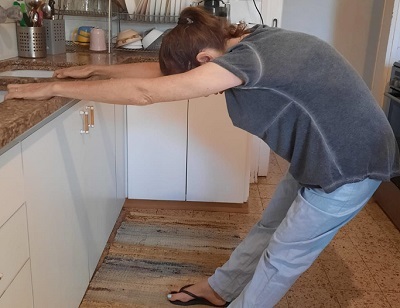
In this exercise, you use your hands and bum to create a wonderful spine stretch (especially for the upper back and shoulders), creating that needed space between your discs.
You can use any sturdy surface you can hold on to, as you can see in the pictures above:
1. While holding onto the surface, slowly lean back and completely straighten your elbows. You may straighten your legs and lock your knees, but it’s not necessary.
2. Try to lean all your weight back behind you.
3. Stay in this position for 20-30 seconds, focus on deep breathing towards your lower back.
4. Slowly step towards your hands, let go of your grip and slowly pull your shoulders back when you get back to standing.
5. Repeat 2-3 times or as much as needed throughout the day.
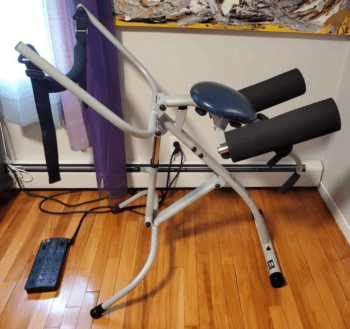
Enhance with the Sit and Decompress
The back harness takes advantage of the strong pull of gravity along with your body weight to hold your upper body in place while decompressing your mid and lower back (lumbar spine) – in only 3 minutes daily.
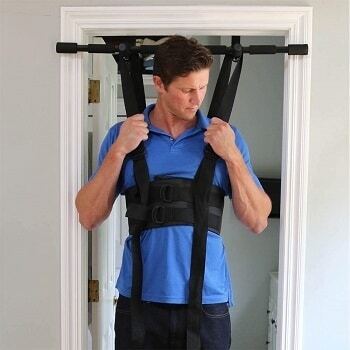
This can instantly increase the space between your spinal discs by 20%! You can choose from 3 sizes to fit your body type, and the cost is about $38 on Amazon
2. Overhead Stretch (Best for Upper Back)
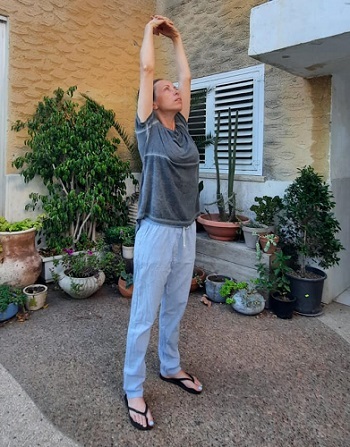
This is a very easy yet effective spine stretch that does not require any equipment or a surface to hold on to. You can do it anywhere – at home, at the office, outside, or on a worksite.
It will elongate your spine while strengthening your shoulder muscles at the same time.
1. Stand on even ground with your legs shoulder-width apart
2. Reach both of your arms above your head and then interlace your fingers
3. Now in this position, take a deep breath, and with your fingers interlaced and elbows straight, try to reach up and touch the ceiling as much as you can without feeling pain.
4. Hold for 10-30 seconds based on your comfort levels
5. Repeat as needed throughout the day
3. Child’s Pose Stretch (Prayer Stretch) – Best Yoga Pose
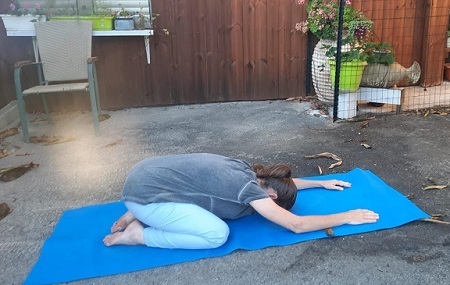
The child’s pose stretch is my favorite yoga pose because not only does it stretch the spine effectively, it is also so relaxing and stress-relieving that you may even fall asleep right after it.
You can do it on a carpet, in your bed, or on any surface that has some cushion for your knees. Even a folded towel on the floor is enough.
1. Start by getting down on all fours. Slide your glutes back until they touch your feet.
2. Now reach forward with your hands as far as you can go. Hold this pose for at least 20 seconds (though it feels so good you’ll want to continue).
3. Slowly back up while arching your back until you are sitting straight.
4. Repeat 1-2 more times daily.
4. Lumbar Arch Stretches (Best for Lower Back Pain)

The two stretches you’ll find below are especially effective for lower back stiffness, lumbar degenerative disc disease, and sciatica. Creating an arch in the lumbar area can gently decompress your spine, followed by immediate pain relief.
(If you add a vibrating massage roller you can supercharge your results and actually enjoy the stretch )
You can do these stretches on the floor and even in your bed, as long as you have a supportive mattress.
RELATED: What’s the Best Hybrid Mattress for Back Pain Sufferers?
Lay down on your back and place a firm and small pillow under the natural low back curve. Take deep breaths directed to the lumbar area for 60 seconds. To enhance the stretch, straighten your legs and lift your hands over your head.
Enhance with an Orthopedic Back Stretcher
Arched back stretchers take this simple exercise to the next level and allow you to fully adjust the strength of your stretch so you can make progress and enhance decompression over time.
The low-cost option is the highly popular orthopedic back stretcher:
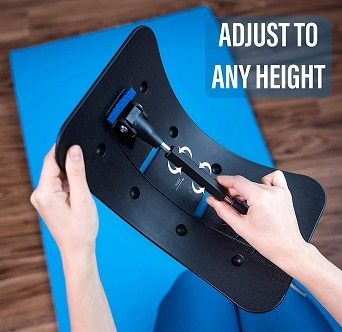
These simple, no-assembly devices are anatomically shaped to conform to your spine and realign your vertebrae, to help improve your posture and relieve compression in your nerves and discs.
RELATED: The Top 7 Orthopedic Back Stretchers
However, my favorite tool for non-powered spine decompression is the back roller wheel:

The back roller wheel follows the natural curve of the spine to fit perfectly between the shoulder blades. When you roll your back over it, it stretches your back muscles, massages them, and at the same time, provides spine traction and takes the pressure off the discs.
RELATED: The Top 4 Back Roller Wheels
5. Cat-Cow Stretch
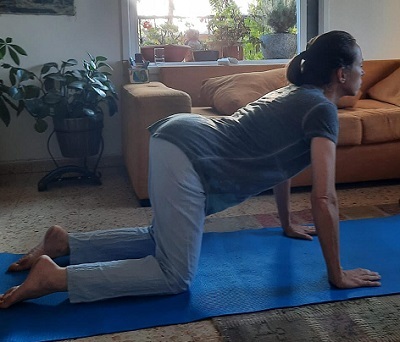
The Cat Cow stretch (also known as the cat camel stretch) is another popular yoga and pilates back pain relief exercise to practice daily. It decompresses your spine while strengthening your core muscles at the same time.
And the best news? You’ll almost certainly get a good back crack while you’re at it.
According to physical therapist Dr. Nicole Lombardo, this exercise has delivered great results for her patients.
1. Get on the floor by getting down on all fours. Position your hands so they are right under your shoulders and your knees and in line with your hips.
2. Take a deep breath and arch your back downwards while lifting your chest and head to a cat pose. At this point, you may feel a wonderful back crack that suggests that pressure was relieved from your discs.
3. Then exhale, and now push your torso towards the ceiling, creating a hump-like posture (camel pose), while relaxing your head toward to floor. Try to “glue” your belly button to your back to enhance the stretch.
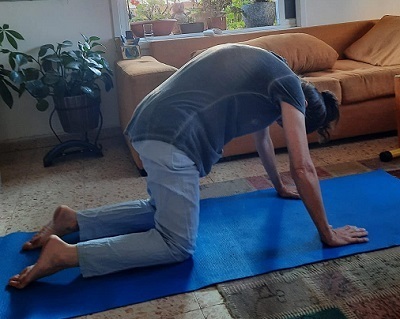
4. Repeat 3 times, and mind your breathing. Inhale for the cat pose and exhale for the camel pose. Breathing is very important.
6. Supine Twist Stretch – Best for Sciatica
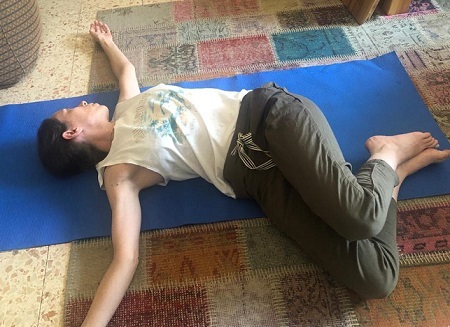
The second stretch is the supine twist. This stretch not only helps to stretch your lower back but also your glutes, which can tighten when you’re experiencing lower back pain, ultimately causing more pain.
1. Begin by lying on your back with your knees bent and feet flat on the floor, and extending your arms out to the side.
2. Keep your shoulders on the ground as you gently roll both knees to one side. Stay here for 20-30 seconds, then return your knees to the center and repeat on the other side.
3. Turn your head to the opposite side of your knees and breathe deeply. If the stretch is too much for you, place a pillow or stack of blankets under your knees.
Here’s how to do this seated:
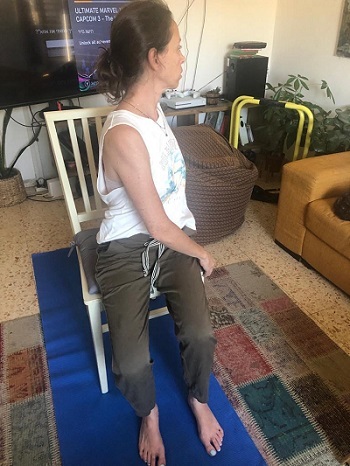
Sit with your back straight. Move closer to the edge of the chair. Slowly start rotating your upper body to one side.
Lift your chest towards the ceiling to enhance the stretch and breathe deeply.
Avoid pushing too hard to twist your body.
7. Knee-to-chest Stretch (for Lumbar Pain Relief)
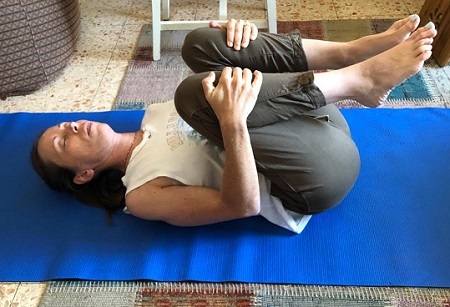
This stretch relaxes your hips, thighs, and glutes while arching your back and creating space between your lumbar discs, especially those commonly injured L4 and L5.
1. Lie on your back with both knees bent and your feet flat on the floor.
2. Draw both your knees into your chest, clasping your hands behind your thigh, or place them on your knees.
3. Hold this position and breathe deeply for 20 seconds, and then gently swing your hips to both sides for a good, relaxing massage.
4. Hold this pose for 1 to 3 minutes.
8. Seated Forward Fold Exercise (Best for Shoulder Pain)
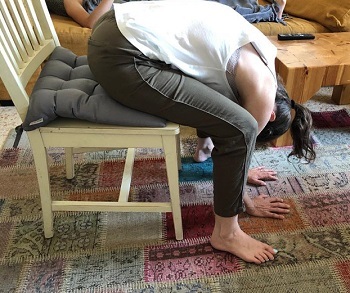
This stretch is great, especially when you feel extra tight in your shoulders and upper back.
You can do it on a chair at home, at the office, or even on a park bench.
Start by moving forward, spreading your legs, and then simply reach down towards the ground, feeling the stretch and taking deep breaths.
Stay in the position as long as you feel comfortable.
To enhance the stretch, lock your legs behind the chair legs, push your bottom all the way back, and release your hands all the way down while trying to reach the floor with your elbows.
Don’t forget to breathe.
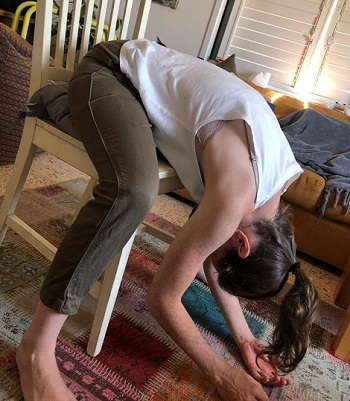
Home Device Option
If you are concerned about falling or not being able to grip the sink well, here’s a simple device to help you do this stretch safely and effectively:
CoreStretch was originally developed for Physical Therapists to help their patients stretch their entire back safely, by using the body’s natural traction.
Decompression Exercises Safety Rules
All these wonderful spine stretches must be done carefully and started gradually.
Don’t try to overdo the stretches, and they are not supposed to be painful. If you feel pain, stop immediately to avoid further injury.
Deep breathing enhances and improves the outcome of all these stretches. Breathing helps your body relax and deliver the oxygen needed to support this activity.
The basic rule is to inhale before you stretch and exhale when your spine is being stretched.
If you are not sure these exercises are safe for your back condition, consult with your doctor, chiropractor, or physical therapist first.
Exercises to Avoid When You Have Back Pain
Some popular exercises may not only make your pain worse but also cause more damage, whether you can feel it or not.
These otherwise effective exercises can pull your spine out of alignment, put too much pressure on your disks, pinch a nerve, or just cause (more) unnecessary back pain.
Here they are:
How to Take Spine Decompression to the Next Level
If you feel you are ready to take your back pain relief and healing to the next level, it’s time to consider some of the best back traction home devices and add some more power to your daily stretches.
Back traction home devices make it easier to decompress your spine and are a solution for people who are unable (due to their condition) to do daily stretches that require physical effort.
To your health and happiness,
The Back Pain Relief Products Team
Studies
Choi J, Lee S, Hwangbo G. Influences of spinal decompression therapy and general traction therapy on the pain, disability, and straight leg raising of patients with intervertebral disc herniation. J Phys Ther Sci. 2015;27(2):481-483.
Kang JI, Jeong DK, Choi H. Effect of spinal decompression on the lumbar muscle activity and disk height in patients with herniated intervertebral disk. J Phys Ther Sci. 2016;28(11):3125-3130.
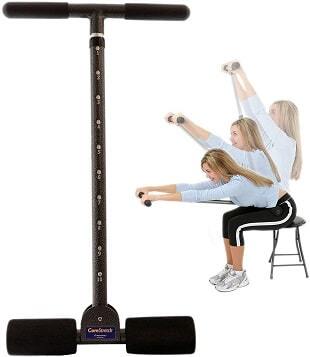
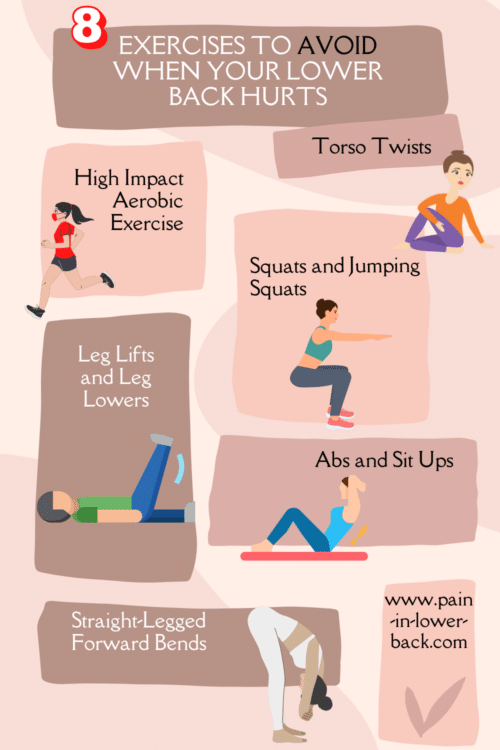


Very helpful.
Thank you